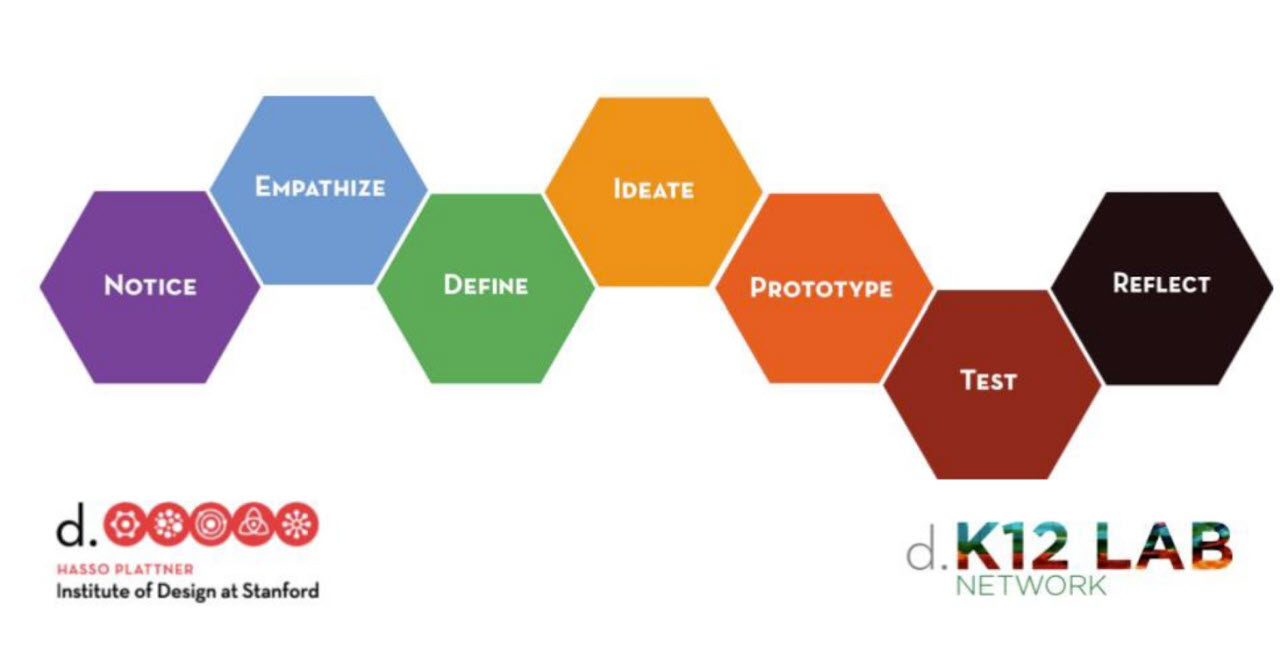Hyla Stories
Human-Centered Design for a Better World

by Brad Waugh, upper school Math teacher.
Human-Centered Design for a Better World is an Aperture course at Hyla’s upper school that utilizes the design thinking framework pioneered by the Institute of Design at Stanford. This course is grounded in the idea of learning through doing by:
- Introducing students to the human-centered design framework and a toolkit of strategies and techniques to employ for each of the stages in the design cycle using cases studies and practical challenges, and
- Having students design and carry out a larger project that responds to a current issue of relevance to them and a community they belong to.
With an emphasis on empathy, the design framework ensures that both the process and the outcome of the projects prioritize the human needs of those impacted and cultivate strong, sustainable relationships with them.

Introducing the Design Cycle
Students got their first insights into the design process by examining a pair of case studies: the development of the d.light to address the dangers and expense of kerosene lanterns used in developing countries and the Noora Health project’s efforts to improve the outcomes of patients at a hospital in Mysore, India. Students reflected on these cases and worked together to apply the human-centered design framework to see how each of its stages can be seen in action.
Later in the semester, students had another opportunity to practice and build their understanding of the framework through the Backpack Challenge. They were tasked with bringing a day pack for an imaginary hike in the Duckabush forest, only to discover that what was initially planned as a day hike had turned into a survival situation lasting a week or more in the wilderness, relying solely on the contents of their packs. They utilized the steps of the design cycle to assess and define their immediate needs and then formulated plans to meet one particular category of those needs individually or in pairs. Over the next classes they gleefully – and skillfully – developed, prototyped and tested their ideas to secure drinking water, build a shelter, start a fire and obtain food.

Stocking Your Toolkit
Just as athletes and musicians use focused practice to improve their technique and performance on the sports field or stage, we use smaller challenges in the classroom to learn and hone techniques used for the design steps. Students were introduced to the use of empathy interviews as a way of gaining a deeper understanding of people and their needs – an essential goal at the empathy stage in the design cycle. To get better at doing empathy interviews the students watched sample empathy interviews and then practiced the technique on each other in order to get an insight into each other’s experiences of learning.
In this sample empathy interview, Jamila Dugan interviews her daughter Gia about her experience at school. In another example, students were introduced to the prototyping step of the design cycle and then the technique of rapid prototyping. They practiced the technique by producing five prototypes for a chair using different materials (paper & pencil, chewing gum, copper wire, cardboard & tape and pasta & marshmallows). The exercise was followed by personal reflection and class discussion to explore how this tool allowed them to test their ideas and generate new ones. Students used the Five Chairs exercise to practice rapid prototyping.

Putting it All Together!
Ultimately, students apply the design framework and tools they have learned to design and carry out projects of their own choosing—projects with a human and community focus. Students are deeply engaged and have partnered with communities close to home and further afield to address a range of issues. The project topics are:
- Supporting Helpline House with a drive for hygiene items which are in short supply and are not covered by current programs such as food stamps.
- Increasing access to cleaner cooking fuels by investigating and testing alternative materials to act as binding agents in biochar briquettes.
- Designing and building a bike shelter on the upper school campus, possibly with a green energy sourced e-bike charging station and bike repair tools to encourage greener ways of getting to school among Hyla US students.
- Minimizing the time and energy spent by Hyla US students looking for and managing parking around the school.
- Developing a student run tech maker space in building 385, installing a 3D resin printer and possibly further equipment, to enhance student engagement and technology skills.
Making Connections
Communication and collaboration play central roles in the language of 21st-century skills. Through their projects, students have had ample opportunities to employ both. When making connections with their communities, students have reached out through phone or email conversations and have met with various stakeholders, including civic politicians here on Bainbridge, researchers with the Estufa Finca Project in Costa Rica, tech companies, individuals at Helpline House, BARN, local businesspeople, and Hyla students, parents, administrators, and faculty. More often than not, these interactions have developed into ongoing and fruitful relationships, but not always. In cases where this is not true, students have learned to lean on and build their resilience and flexibility—also important skills!
Students will continue to work on their projects throughout the semester, eagerly anticipating the implementation of their plans and the sharing of results with the community.
